NVIDIA GeForce 8800 Ultra 768MB
|
Contents
- Introduction
- Graphics card features
- Testbed configuration, benchmark list
- Test results
- Conclusions
The card
| NVIDIA GeForce 8800 Ultra 768MB PCI-E |
- GPU: GeForce 8800 GTX (G80)
- Interface: PCI-Express x16
- GPU (ROPs/Shaders) clock rate: 612/1512 MHz (612/1512 MHz
default)
- Memory clock rate (physical (effective)): 1080(2160) MHz
(1080 (2160) MHz default)
- Memory bus: 384-bit
- Vertex processors: n/a
- Pixel processors: n/a
- Universal processors: 128
- Texture processors: 32
- # of ROPs: 24
- Dimensions: 270 x 100 x 33 mm (the latter is max. thickness)
- PCB color: black
- RAMDACs/TDMS: on a dedicated chip
- Outputs: 2 x DVI (Dual-Link), TV-Out
- VIVO: n/a
- TV-Out: integrated into GPU.
- Multi-GPU support: Hardware SLI
|
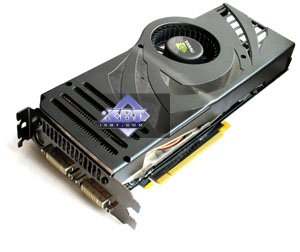
|
| NVIDIA GeForce 8800 Ultra 768MB PCI-E |
| 768 MB of GDDR3 SDRAM in 12 chips on PCB face.
Samsung
GDDR3 memory chips. 0.8 ns fetch indicates 1250 (2500) MHz clock
rate.
|

|
| Comparison to reference, front view |
| NVIDIA GeForce 8800 Ultra 768MB PCI-E |
Reference card NVIDIA GeForce 8800 GTX |
 |
 |
 |
 |
| Comparison to reference, back view |

|
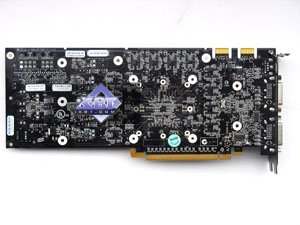
|
You can clearly see PCB is the same as that of 8800 GTX. It would be strange to expect anything else, since the difference is not that great. Even the 7800 GTX 512MB was more different from 7800 GTX 256MB.
Again, I shall remind that today NVIDIA orders all 8800 GTX/Ultra graphics cards from partners, which purchase not separate GPUs, but ready cards. At a stretch we can say that NVIDIA makes these cards itself, using partners to channel sales. (This resembles 3dfx a bit, but NVIDIA doesn't turn away from partners, like 3dfx did.)
The PCB features GPU under a huge cover. The general dimensions are great as well, considering the 384-bit bus. As you can see, the core has revision A3 (8800 GTX features A2 core).

The auxillary NVIO chip with image output processors (RAMDAC, etc.) also has a newer revision.
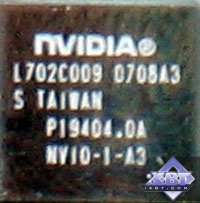
The card features a unique TV-Out that requires special (bundled) adapters to ouput data via both S-Video, and RCA.
To d-Sub (VGA) interfaces the product connects via special DVI-to-d-Sub adapters. Max. resolutions and frequencies:
- 240 Hz Max Refresh Rate
- 2048 x 1536 x 32bit @ 85Hz Max - analog
- 2560 x 1600 @ 60Hz Max - digital (both DVI connectors of 8800 series are Dual-Link)
Speaking of MPEG2 (DVD-Video) playback capabilities , depending on a movie CPU load doesn't exceed 25% on all modern graphics cards. As for HDTV and other innovations, we shall conduct a complete examination of these as soon as we have a chance.
The card requires additional power, so there are two additional black 6-pin connectors. A PSU adapter to Molex connectors is bundled.
Now let's turn to the cooling system.
| NVIDIA GeForce 8800 Ultra 768MB PCI-E |
|
The cooler is based on the same principle as that of 8800 GTX.
But they slightly changed heatsink and enlarged the housing.
The core and memory chips as well as NVIO and some power elements
are covered by a single heatsink base with a copper plate for
the core.
Other cooling elements contact heatsink via fablic gaskets.
Since the fan is partly located outside PCB limits, the heatsink
is generally larger. We don't know why they had to resort to
such sophistications, when a usual GTX cooler is able to cool
this monster all right.
The key drawback of this cooler is its huge housing covering
the entire card, including its rear. But since the card itself
is very long, on most motherboards it will set again SATA ports,
which vendors very much like to put right opposite PCI-E x16
slots. While before it has been a mere narrow textolite piece
able to fit between SATA ports, now it's a huge housing too
big to fit between SATA ports or any other. So you either have
to find SATA cables with 90° rotated connectors, or find
yourself another graphics card or motherboard.
nForce 680 motherboards had this issue solved - on them SATA
ports were located elsewhere, not preventing such long and thick
graphics cards from being installed. But we have to consider
that the absolute majority of users evidently have motherboards
of other level and class.
|
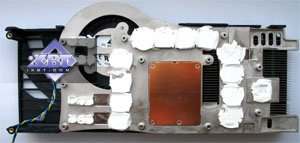
|

|
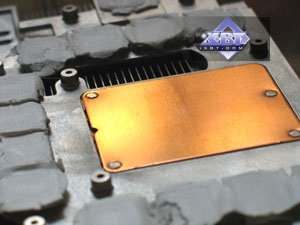
|
Having examined the temperature conditions with RivaTuner (by A.Nikolaychuk AKA Unwinder), we obtained the following results:
NVIDIA GeForce 8800 Ultra 768MB PCI-E

As you can see, the temperature doesn't exceed critical (90° and higher), and cooler noise isn't excessive as well.
Write a comment below. No registration needed!
|
|
 |
|
|
|



